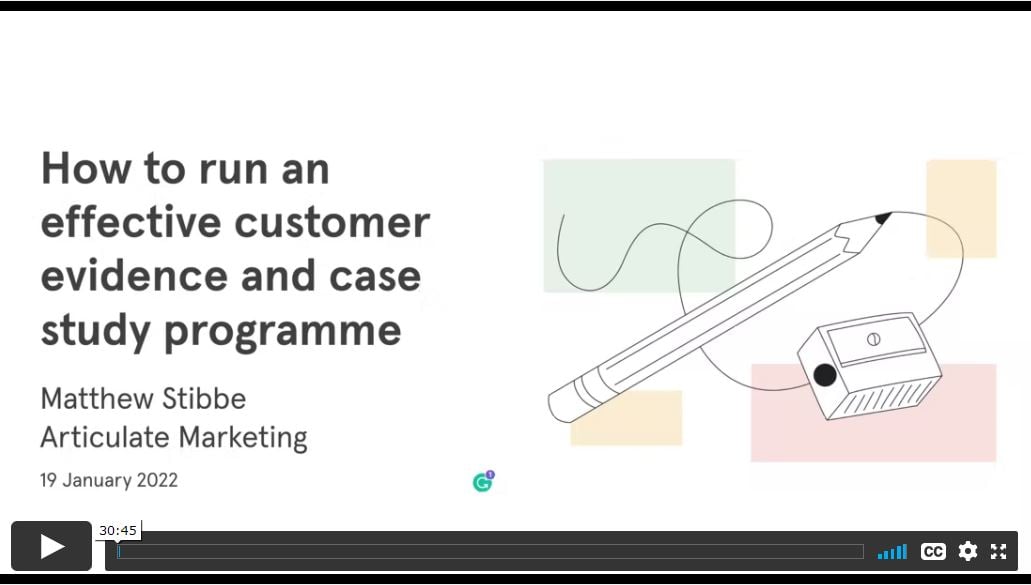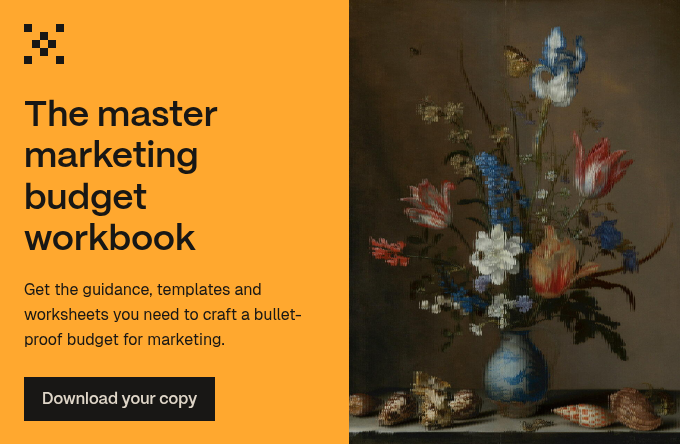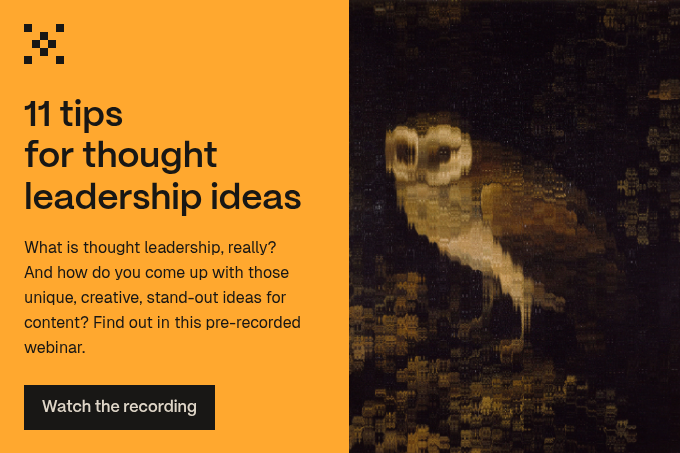A case study is proof.
It’s proof that you can deliver on your promises. And proof that what you do actually works for your customers, and that they are happy. Social proof is powerful. In fact, 91 percent of respondents in this survey said they read at least one review before making a purchase decision.
Case studies shouldn’t be the sole focus of your marketing efforts, but they do serve an important role in persuading buyers in the middle and bottom of your marketing funnel. Today, we’ll give you the tools you need to turn your work with clients into compelling success stories.
This article is based on one of our webinars. Watch the video and download the slides, here:
Building a customer evidence programme
A customer evidence programme encompasses anything you do to demonstrate past successes with clients, including reviews and case studies. Case studies are the premier format for customer evidence, so we’ll focus on them in this article.
Before you launch into writing a case study, take these five steps:
1. Get everyone on board
Case studies are a team effort. You need to enlist and incentivise the whole team to build a proper customer evidence programme.
At Articulate, the client services team, the sales team and the studio all have objectives and KPIs centred on customer evidence. We measure the number of case studies, reviews and HubSpot Impact Awards that we do each quarter. And this means everyone is invested in our customer evidence programme.
We also build it into contracts with customers to ensure we have a legal right to promote our work together from the get-go. Then, when we get a positive ‘trigger’ like a good NPS (Net Promoter Score) from a client or a successfully complete a project, we can initiate the case study conversation right away.
2. Identify opportunities
Start one or two months ahead of when you need the case study written. To get one case study written you will want to broach the subject with about three customers. This is to account for attrition or delays caused by multiple rounds of approvals.
Remember, doing a case study is a pretty big favour to your business. It’s an investment of time, and your customers are probably busy people. If possible, try to offer something in return.
3. Recruit interviewees
Make and send a boilerplate email request for an interview with the subject of your case study. Except don’t use the word ‘interview’. It scares people. Just ask for a quick chat. Keep the email short and provide a meeting link to smooth the path to progress. Use this as a chance to identify potential blockers (the PR department) and to reassure the recipient that they will have the chance to review and approve the case study. This starts things off on the right foot.
4. Incentivise your customer
Give something to your customer to make the effort of doing a case study worthwhile. One thing you can offer is free access to the resultant copy, which they can chop and change to suit their purposes, too.
Reputation is also a genuine commodity in this exchange. You can persuade customers of the benefits of a case study that highlights something about their company that would benefit them commercially. For example, if you’ve shored up their data security, then that’s a positive selling point for them.
From a marketing perspective, a lot of companies are motivated by backlinks. If you're going to promote a case study on a website that's got a high domain authority, then your customer will get the benefit of an authoritative backlink, which is great for SEO.
You could even do something like plant a tree for every case study. Call it a ‘feedback forest’.
5. Engage them in the interview
The secret of a good case study interview is to not try to unpack the whole story. You can get that stuff from your internal team. What you're trying to get out of the customer is a couple of good quotes and some statistics, if they’re available.
Most of the time, people turn up for case study interviews with good intentions. They are perfectly willing to say nice things about your partnership. They know the deal. So, respect their time and listen attentively. It should feel like a short, friendly conversation where everyone comes away happy.
We’ve covered the subject of interviews extensively in this article: How to interview like a journalist. So, we won’t go into that further here.
Writing a compelling case study
Once you’ve done your interviews and gathered your facts, it’s time to write the case study. Thankfully, case studies are pretty formulaic.
Here’s a simple structure that you can follow:
- Title. Keep titles short and enticing. Don’t try to summarise the case study in one title.
- Standfirst. Write a 20-30-word synopsis that covers the main gist of the case study.
- Pull quote. Put this quote in the sidebar or have it stand out from the main body text. It should be pithy and compelling.
- Introduction. Set the context and introduce the customer (or internal department if these case studies are for internal circulation. We’ve done dozens of these for Dell.).
- Problem. Describe the challenge that you were brought in to solve. Think of Rudyard Kipling’s ‘six serving men’: what, where, why, when, how and who.
- Solution. Talk about how you helped the customer. What did you do? How long did it take? What technology did you use? This is the bulk of the copy, so in a 600-word case study, this would be about 3-400 words.
- Working with company. This is a good place for another customer quote. Put something here about how well your teams collaborated.
- Benefits. Think about the results of your engagement. Did you solve the problem? Here is where you can put the hard numbers, if you have them.
- Conclusion. Put another quote here. That makes a strong ending. And talk about ‘what next’. What can the customer do now that they couldn’t do before now that you’ve solved their problem?
As an example, here’s a case study we wrote for Microsoft:
How Wellington College transformed its learning environment with Microsoft Surface and Autopilot (Download the PDF)
Common challenges
Approvals
Case studies are pretty straightforward to write, but the process of generating a case study is pretty complex.
Getting approvals can be a pain. We've had case studies going through approval cycles for months and months. To avoid this, we suggest rephrasing the approval request. Instead of, ‘Please can you approve this case study’, try, ‘This case study is going live in a week so please let me know if you have any objections before then.’
This, of course, depends on your relationship with the person or business that is a gatekeeper to progress. In the end, if you can't get the approval, there's nothing stopping you anonymising the case study.
Frankenquotes
A frankenquote is not something someone said, but something a writer pretends they said.
They never ring true. They sound like advertising copy, most of the time. It’s better to use reported speech or get a real interview. (Oh, and TL;DR: shorter quotes are generally better than longer ones.)
Unrealistic expectations
When it comes to case studies, you can only work with what you’ve got. If you didn’t get the best quotes from your interviewee, then you just have to deal with that, and so does whoever is approving your case study.
Similarly, most people think case studies have to have numbers in them, but sometimes you just don’t have that data, or it doesn’t make the best story. That doesn’t mean it won’t work as a case study, but you need to manage your expectations and be flexible.
How to use customer evidence
Once you have your case study written and approved, it’s time to share. One case study can serve multiple purposes. Here are some suggestions:
-
Reviews. If your customer is willing, ask them to post reviews on third-party directory sites. These can even be direct quotes from your case study. Try Google reviews, LinkedIn or Clutch.
We’re a HubSpot Partner. So, we focus our attention on getting good reviews in the HubSpot Directory.
-
Customer quotes. Use quotes throughout your website, such as in a carousel module. You can also recycle these from existing case studies.
-
Logo tombstones. Put client logos on your website, such as on the home page. The more recognisable, the better; even more so if you have a case study to back up the logo.
-
Win cards. We have a database of mini case studies, or ‘win cards’ for our business development team to refer to when speaking with prospects. Each one includes various tags, such as company size, and information on the client’s challenge, what we did and how it helped. These have proven very useful in sales conversations.
-
Blogs as case studies. Case studies come in a variety of formats. There’s certainly a case for putting them on your blog, as you can then promote them on social media and categorise them as part of your resources.
-
Standalone pages. Or you can build unique web pages for your case studies. It’s a bit more effort than just posting the copy to your blog, but it means you can do more interesting things with the format and imagery.
-
Gated PDFs. Yes, you can put your case study on a PDF. Although, we suggest just making a web page instead, if you’re going to all that bother. And we strongly recommend not gating your case study behind a form.
-
Sales emails. If you’re contacting prospects, then one of the best uses for a case study is to include it in an email. In HubSpot, we can automate this using email templates with placeholders for content such as case studies. That makes it easy for us to fire off an email with a relevant case study in a matter of seconds.
Hire an agency to write your case studies
The writers at Articulate have produced hundreds of case studies for a variety of B2B technology companies, including big-name enterprise businesses like Dell and Microsoft. You can see the case studies we’ve written for ourselves, here. Painfully meta, we know.
Or, speak to our sales team about hiring us to build out your customer evidence programme.




.webp?width=400&height=250&name=Frame%201%20(9).webp)
.jpg?width=400&height=250&name=europeana-cguOW7oi5TM-unsplash%20(1).jpg)

